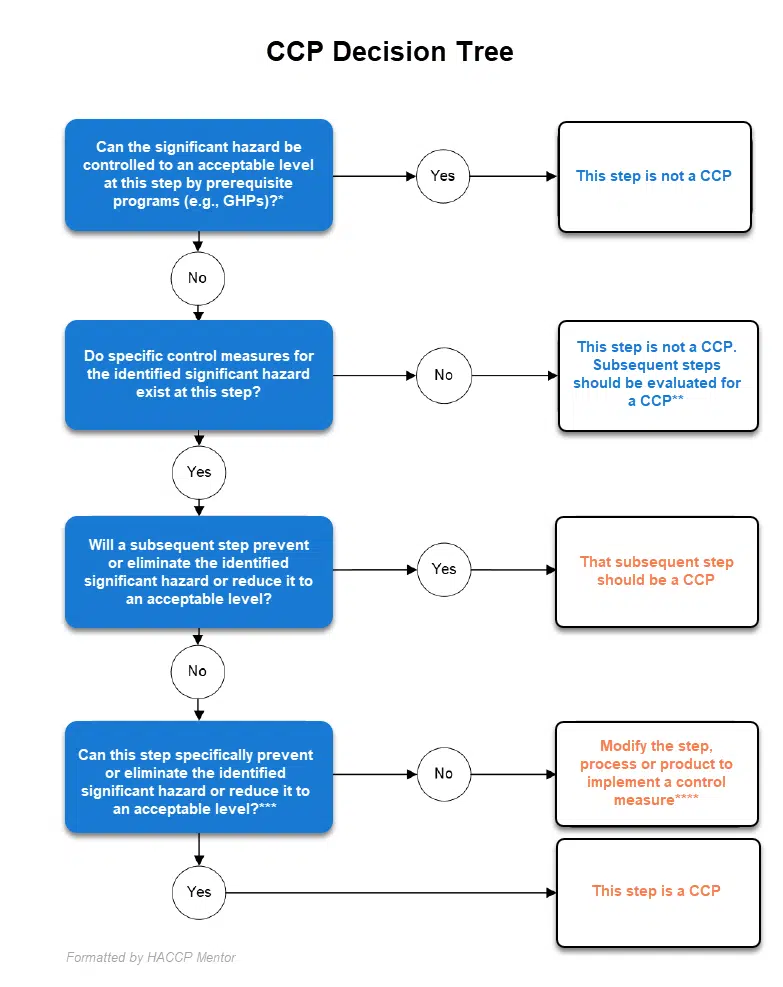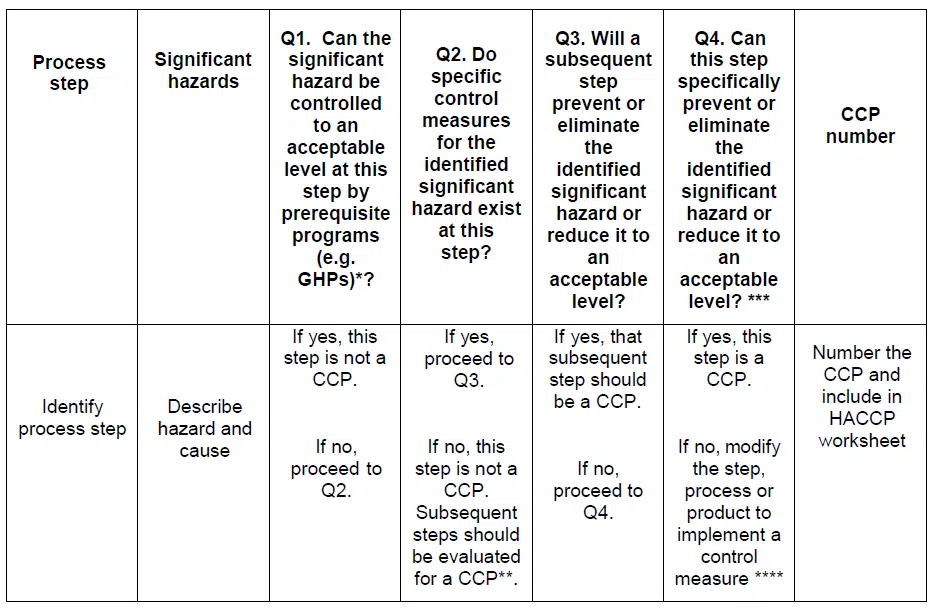In February 2023, the Codex Alimentarius Commission reported the adoption of the revised General Principles of Food Hygiene (CXC 1-1969) during CAC45. One of the key outcomes was the finalisation of the revised CCP Decision Tree by the Codex Committee on Food Hygiene.
An example of a decision tree to identify CCPs (commonly known as the Codex CCP Decision Tree) documented in the previous 2003 version was not included in the September 2020 release. However, Codex HACCP 2020 still made reference to using a decision tree or other approach to identify critical control points (CCPs).
Keep reading to discover how the decision tree works and its importance in identifying critical control points (CCPs) to minimise food safety risks.
Revising the CCP Decision Tree
The revised decision tree was developed by the Codex Committee on Food Hygiene (CCFH). This committee is made up of 188 members countries and 1 Member Organisation (The European Union).
Discussion by the CCFH highlighted that a decision tree was a very useful tool for both competent authorities and food business operators, in particular small and less developed businesses, in identifying CCPs. It was also noted that the decision tree in the former version of CXC 1-1969 had been globally used and understood by all users.
The Codex CCP Decision Tree
The Codex CCP decision tree involves answering a series of questions in order to identify critical control points (CCPs). This tool that helps to systematically determine which steps in a process are most critical for food safety. By answering a series of questions, businesses can identify areas where food safety risks are highest and implement appropriate controls to minimise those risks.
The Codex CCP decision tree is one example of a decision tree that can be used to identify CCPs. Food businesses are not obligated to use this tool as part of CCP determination. Other tools can also be used as long as they meet the general requirements of Principle 2 – Determine the critical control points (CCPs).

A 4-Step process
The Codex CCP decision tree involves answering four (4) questions. These questions must be answered in order. The answer to each question will either be ‘YES’ or ‘NO’.
Keep in mind that as part of completing a hazard analysis (HACCP Principle 1) you are required to identify ‘significant hazards’. You would therefore use the decision tree to answer the questions about the significant hazards you have identified during that process.
Let’s take a look a the four questions now.
Question 1: Can the significant hazard be controlled to an acceptable level at this step by prerequisite programs (e.g., GHPs)?*
Question 2: Do specific control measures for the identified significant hazard exist at this step?
Question 3: Will a subsequent step prevent or eliminate the identified significant hazard or reduce it to an acceptable level?
Question 4: Can this step specifically prevent or eliminate the identified significant hazard or reduce it to an acceptable level?
Annotated provisos
There are some provisos included which are annotated with the asterisk symbol(s). These are:
*Consider the significance of the hazard (i.e., the likelihood of occurrence in the absence of control and the severity of impact of the hazard) and whether it could be sufficiently controlled by prerequisite programs such as GHPs. GHPs could be routine GHPs or GHPs that require greater attention to control the hazard (e.g. monitoring and recording).
** If a CCP is not identified at questions 2-4, the process or product should be modified to implement a control measure and a new hazard analysis should be conducted.
***Consider whether the control measure at this step works in combination with a control measure at another step to control the same hazard, in which case both steps should be considered as CCPs.
****Return to the beginning of the decision tree after a new hazard analysis.
When you use the decision tree, make sure to consider the provisos at each step and response where indicated.
Documenting the Codex decision tree process
Like anything HACCP you are required to document your use of the CCP decision tree. The Codex Committee on Food Hygiene (CCFH) have proposed a example of a CCP determination worksheet that can be used for this purpose. You can see this below.

I have included my take on this example and included it in my Food Safety Plan – HACCP template.

Get up to speed
If you would like to learn how to use this tool to correctly identify your CCPs, register below to be notified of my upcoming free training.
Have your say
What do you think of the revised CCP decision tree compared to the previous version? I personally like the use of prerequisite programs to control significant hazards allocated in question 1. This will work well for those food businesses that have 3rd party GFSI recognised certification. Let me know your thoughts in the comments below.



To me, HACCP is meant to apply step by step in a simple way. We are recommended to analyze the status of each step whether it could be a CCP or not a CCP. I do not understand the logic to have question number 3 in between because that question is de-focusing the analyzer from the current step to a subsequent step. Should not we focus and stay on the current step while analyzing status of that particular step only?
Keep in mind that Principle 2 (Identify CCPs) is different to Principle 1 (Conduct hazard analysis). The logic is if the hazard can be controlled at a later point in your flow process, that is where it is critical for it to be controlled. Further explanations will be provided during the training.
The approach where the article says “Consider the significance of the hazard (i.e., the likelihood of occurrence in the absence of control and the severity of impact of the hazard)” is not helpful.
Because the ‘likelihood of occurrence in the absence of control’ is a totally artificial concept and ought never be used.
Firstly, what exact ‘control’ is (or controls are) absent?
Our pre-requisite controls can’t be absent as these are pre-requisite. A food business ought never consider the likelihood of a hazard other than through the lens and in the context of the food business having a mandatory suite of effective prerequisite programs in place.
To emphasise the point, I cannot think of a single step / unit operation in a food business’s flow diagram that would not in time pose a significant hazard to food safety with no control (I.e. in the absence of control).
Secondly, almost every food safety hazard (and certainly every significant hazard) is a real problem in the absence of control.
After all, a significant hazard (like Salmonella or E.Coli H7:157) ‘in the absence of control’ has a credible, foreseeable worse case scenario of causing death in an affected / infected consumer.
These factors together mean every time a hazard – or indeed a significant hazard – is considered in the absence of control must by definition lead to that hazard being rated as a potentially causing a consumer injury, illness or death – which is not helpful.
Using the “likelihood of occurrence in the absence of control and the severity of impact of the hazard” approach also turns what should be a straight forward HACCP hazard analysis process into a convoluted, time-consuming confusing RACCP risk assessment process. It’s HACCP not RACCP.
The Camden BRI decision tree is much better than the Codex decision tree, as the Codex tree doesn’t seem to help the user understand / identify the difference between a significant food safety hazard and one which is a not-significant food safety hazard.
For example, the first Codex decision tree question is asks ‘Can the significant hazard be controlled to an acceptable level at this step by prerequisite programs (e.g., GHPs)?’
This question is bound to confuse – because by definition – a significant food safety hazard is one which cannot be adequately controlled by prerequisite programs. So asking if a significant hazard (being a hazard which cannot be adequately controlled by prerequisite programs) can be controlled by prerequisite programs is a non-sense and confusing.
While the Camden BRI and both the old and newly updated Codex decision trees can work in the hands of a skilled HACCP practitioner (or HACCP Mentor such as yourself) I predict this Codex decision tree will lead to confusion just as it’s predecessor did.
Thanks James for your insights on this, and yes, it can be very confusing. I just look at it like this – The whole piece about identifying significant hazards occurs during Principle 1. Determining if that ‘significant’ hazard is then also ‘critical’, happens at Principle 2. This is where the Codex decision tree comes in. Having a decent hazard analysis tool (e.g. 3×4 risk assessment framework), to use as part of Principle 1, I think, is crucial. You can definitely have hazards that are ‘significant’ but not ‘critical’ at one step but then that same hazard be ‘significant’ and ‘Critical’ at another step later down the track.
I agree with you here, Amanda. If Principle 1 has been done properly, with full consideration, then appropriate significant hazards have been identified for further consideration. This decision tree is much simpler than the previous version (and in truth I only ever used these specific questions when developing a plan). Since many organisations confuse true process controls with PRPs, I think this is a great way of reducing the number of true CCPs, without compromising the safety of the product, in real terms.
Thanks for your feedback Cathy. I think this decision tree is much simpler as well. From what I saw during audits, too many people were getting tripped on Q2 in the previous version. (is this step specifically designed …)
This is a great plate-form you to update one with the latest informatioms, amendments being done at Codex level.
Thanks Dharmendra 🙂